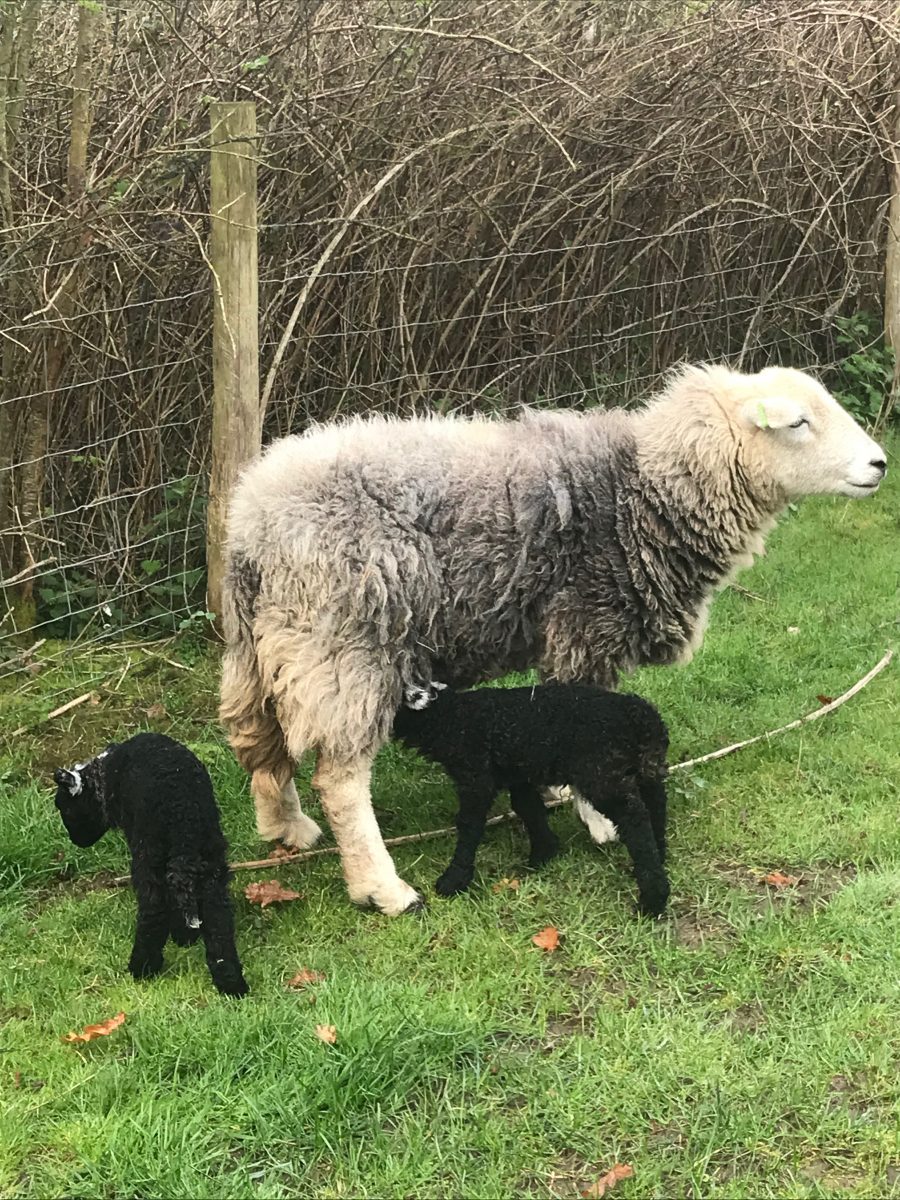The middle of April and, just as things look as if they will dry up a bit, we seem to be dogged by yet more wet, grey and rather dreary days. It’s certainly not ideal lambing weather, particularly for those lambing outside, although doubtless it is shepherds that are more perturbed by the weather than the sheep. Fortunately we haven’t had too many wet and windy nights, which present more of a risk to newborn lambs.
March was certainly an ‘interesting’ month, with the highest UK March rainfall for 40 years; locally the East Malling official weather station recorded a mere six days in the month with no precipitation. We even started lambing with snow on the ground, although that is not that unusual for March. In spite of the inclement weather it has, for us at least, been a relatively easy lambing; some of the first lambs delivered weighed considerably more than anticipated, providing a bit of a scare, but that apprehension soon disappeared as the ewes then settled down to produce some good, strong lambs at rather more sensible weights. In spite of the arrival of quite ‘strong’ lambs, we had very little need of any lambing assistance, and that which was required was limited to straightening out the odd hung elbow or applying a bit of traction for some of the bigger lambs. The latter, I suspect, may well have reached a successful conclusion unaided but with rather more stress on the ewe than desirable.
Genuinely, from the sheep point of view, this season came very close to being an ideal lambing, with most lambs arriving not only unassisted but also unseen, this in spite of frequent visits to the lambing paddock, I reckon that I actually saw considerably less than 20% of the lambs born.
With the exception of four ewes that were stopped by a ram lamb who decided to jump the fence for one night of fun a week before the tups went in, the Lleyn provided us a further bonus with nice tight lambing. Our lambing proper began on 7 March (exactly 145 days from when the tups were joined) and the final ewe delivered on the 24th. This is one of the advantages of having a self-replacing flock, where precocious lambers have, for a number of years, been part of our criteria when selecting our replacements. Lambing can be tiring and stressful enough without it dragging on for two full cycles; our tups are now pulled out after 21 days, generally with zero empties. All things considered, with 200% born and 196% strong lambs tailed, tagged and turned out into the follow on paddock, I consider that we have had a reasonably good year, so far.
The weather, or to be more precise the consequences of the wet weather, did make things rather more difficult; stodging about with a couple of kilograms of mud adhering to your wellies can make life a little harder, although the sheep didn’t seem to mind too much, this in spite of the fact that some of the ewes were beginning to blend into the background as a result of muddy-hoofed lambs constantly jumping on and off their backs. Things did, once April arrived, dry out briefly, but we really need a few more warm, sunny days to get the grass really growing again; to date daily dry matter growth has barely reached balance point where it equals, or hopefully exceeds, daily requirements. That said, with the grass currently available in front of them the ewes do seem to be milking well and lambs look to be shaping up nicely. Eight week weights should be quite interesting.
True to character the Herdwick have not been quite so cooperative and are taking their time, although, to be fair the older ewes have, once they started, got on with it and lambed well. True to form, though, just to make life a little more interesting the last of the tegs has decided to hang on; she has bagged up nicely and I’m sure will lamb when she is ready. I just hope she doesn’t hang on too much longer; it will be good to bring lambing to a conclusion. Needless to say the Herdy ram, who seems to live in his own little breeding world, does not come out at 21 days. He or the ewes are normally only just getting warmed up by then.
From various reports it would seem that, in general, producers have enjoyed reasonably good lambings; inevitably some have not been quite so fortunate, with tales of significant levels of lamb mortality suffered by some who have struggled, for various reasons, to keep mortality figures below what is a reasonable target of around 10%; which leads me quite nicely on to my next point.
Scrolling through Facebook (other social media platforms are available) a while ago I came across a post from what was obviously a novice sheep keeper, seeking advice on a “difficult lambing”. Quite simply, a ewe had delivered one lamb, a second was suspected but the ewe was taking her time; “what to do?”. Nothing notable, or is there? My first thought was to wonder what on earth (not quite so polite) this person was doing lambing sheep without any idea about how to deal with a relatively simple lambing problem. What was rather more alarming was the nature of many of the responses and advice offered. They were varied, but most were along the lines of “get in there and pull/rip/drag it out”. It wasn’t until some way down the list of responses that someone countenanced caution, advising that the ewe be given a bit of time and, if the poster was particularly concerned, to simply, after washing hands and using plenty of lambing gel etc, carry out a basic check. Assess the situation and then make an informed decision based upon that assessment; a common sense approach.
It is a matter of considerable concern that both the question and most of the responses demonstrated an appalling level of ignorance and lack of any meaningful understanding, or concern, for the welfare of either the ewe or lambs, which does a great disservice to the sheep industry and to all those hard working and caring sheep keepers who strive daily to ensure that they do the correct thing for their sheep.
Of particular concern was the amazingly negative impression of both practices and attitudes within the sheep industry created by the comments posted on social media. The fact that these people felt it was appropriate to post such, in an open forum, available for all to see, undermines a lot of good work done by others at a time when the sheep sector needs all of the positive publicity it can get in order to promote the industry and encourage consumers to buy British lamb.
The very nature of the original question was such that it was immediately obvious that here was a person who thought it appropriate not only to acquire some sheep but to tup them and attempt to lamb them without appearing to have any significant concern or understanding of what they were doing. They seemingly had so little regard for the sheep or their welfare that they didn’t consider it a good idea, as a novice sheep keeper, to undertake some basic training or gain some meaningful experience before they obtained any sheep, let alone attempted to lamb them.
In addition, the realisation that some of the comments posted in response were quite obviously from working shepherds and/or sheep keepers raises significant questions about the shamefully poor levels of knowledge, understanding and consideration for basic sheep welfare of some working within the industry. I suspect (from Facebook profiles) that some are working within quite large flocks.
These are people who really do owe the majority of good sheep keepers out there a huge apology; many of these are, through lambing open days, chatting to the public etc, determined to present a positive image to help raise the profile of the sector for the benefit of all sheep producers. We really do have some amongst us who, whether out of ignorance or lack of consideration, appear to be well experienced in shooting the whole of the sheep sector in the foot; shame on them.
For more like this, sign up for the FREE South East Farmer e-newsletter here and receive all the latest farming news, reviews and insight straight to your inbox.







